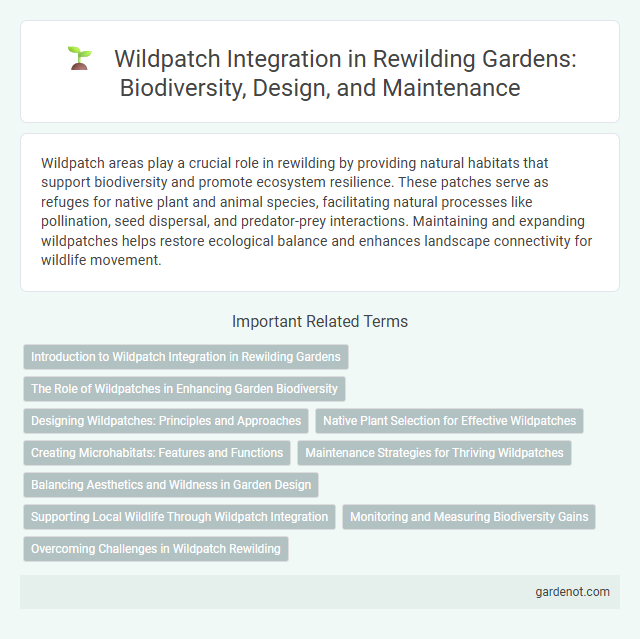Wildpatch areas play a crucial role in rewilding by providing natural habitats that support biodiversity and promote ecosystem resilience. These patches serve as refuges for native plant and animal species, facilitating natural processes like pollination, seed dispersal, and predator-prey interactions. Maintaining and expanding wildpatches helps restore ecological balance and enhances landscape connectivity for wildlife movement.
Introduction to Wildpatch Integration in Rewilding Gardens
Wildpatch integration in rewilding gardens enhances biodiversity by creating natural habitats for local wildlife, encouraging native plant growth alongside wildflowers and grasses. This approach supports pollinators, birds, and insects, fostering ecosystem resilience and connectivity. Employing Wildpatch zones optimizes soil health and water retention, promoting sustainable garden management aligned with ecological restoration principles.
The Role of Wildpatches in Enhancing Garden Biodiversity
Wildpatches serve as vital habitats within gardens, supporting a diverse array of native species such as pollinators, insects, and small mammals. These unmanaged areas provide essential resources like food, shelter, and breeding grounds, directly contributing to increased garden biodiversity. Incorporating wildpatches encourages ecological balance and fosters resilient ecosystems by promoting native flora and fauna.
Designing Wildpatches: Principles and Approaches
Designing wildpatches involves prioritizing native biodiversity through the selection of indigenous plants that support local wildlife and enhance ecosystem resilience. Principles include creating layered habitats, incorporating structural diversity, and ensuring connectivity with surrounding natural areas to facilitate species movement. Approaches emphasize minimal human intervention, adaptive management based on ecological monitoring, and fostering natural processes such as succession and pollination.
Native Plant Selection for Effective Wildpatches
Selecting native plants for wildpatches enhances biodiversity by providing essential habitats and food sources for local wildlife. Native species adapt to local soil, climate, and pollinators, ensuring sustainable growth and minimal maintenance. Incorporating a diverse range of native flora improves ecosystem resilience and supports pollinator populations crucial for rewilding success.
Creating Microhabitats: Features and Functions
Wildpatch designs and implements diverse microhabitats by integrating native plants, varied soil structures, and water features to support local biodiversity. These microhabitats provide shelter, breeding grounds, and food resources for pollinators, amphibians, and small mammals, enhancing ecosystem resilience. Strategic placement of logs, rocks, and wildflower patches promotes species-specific habitats that contribute to pollination and natural pest control.
Maintenance Strategies for Thriving Wildpatches
Wildpatch maintenance strategies prioritize native species planting, regular invasive species removal, and soil health monitoring to sustain biodiversity and ecosystem resilience. Employing adaptive management techniques allows for responsive interventions based on seasonal changes and species growth patterns. Community engagement and educational programs support ongoing care and awareness, ensuring the long-term success of thriving wildpatches.
Balancing Aesthetics and Wildness in Garden Design
Wildpatch integrates native plants and natural habitats to balance aesthetics and wildness in garden design, promoting biodiversity while maintaining visual appeal. By incorporating pollinator-friendly species, native grasses, and natural water features, it creates dynamic, self-sustaining ecosystems that attract wildlife. This approach aligns with principles of rewilding, enhancing urban green spaces without sacrificing garden beauty and structure.
Supporting Local Wildlife Through Wildpatch Integration
Wildpatch integration fosters thriving habitats by restoring native plants and creating micro-ecosystems crucial for pollinators, birds, and small mammals. This approach enhances biodiversity, improves soil health, and supports local food webs, contributing to resilient urban and rural environments. Wildpatch areas act as vital refuges that sustain ecological balance and promote long-term wildlife conservation.
Monitoring and Measuring Biodiversity Gains
Wildpatch employs advanced remote sensing technologies and citizen science to monitor biodiversity gains, capturing data on species diversity, abundance, and habitat quality in real time. Comprehensive ecological surveys combined with automated sensors enable precise measurement of ecosystem restoration progress and the impact of rewilding interventions. This data-driven approach supports adaptive management, ensuring continuous improvement in biodiversity outcomes across rewilded landscapes.
Overcoming Challenges in Wildpatch Rewilding
Wildpatch faces challenges in soil restoration and invasive species management crucial for successful rewilding outcomes. Implementing targeted native plant reintroduction and adaptive monitoring strategies enhances ecosystem resilience and biodiversity recovery. Collaborative efforts with local stakeholders ensure sustained habitat connectivity and protection against anthropogenic pressures.
Wildpatch Infographic

 gardenot.com
gardenot.com